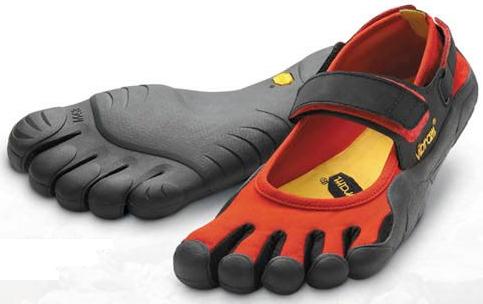 The other week when a guy in my outdoor club overheard that I am a runner, he asked, "Want to run barefoot with me on the indoor track?" I responded by giving him an odd look, giving him time to start explaining himself. He told me about a book titled Born to Run written by Christopher McDougall that addresses the issue of running barefoot, a book of which lead my fellow outdoor club friend to losing his shoes upon running.
The other week when a guy in my outdoor club overheard that I am a runner, he asked, "Want to run barefoot with me on the indoor track?" I responded by giving him an odd look, giving him time to start explaining himself. He told me about a book titled Born to Run written by Christopher McDougall that addresses the issue of running barefoot, a book of which lead my fellow outdoor club friend to losing his shoes upon running.While the book is still on my list of must-reads, I went home and googled the book to obtain a brief synopsis of what it's all about. In the book, McDougall takes his readers on a journey to the Mexican lands of the Tarahumara Indians. Through watching this idegenous tribe of Mexico, McDougall discovers that our modern-day running is entirely all wrong. The Tarahumara Indians could possibly be the world's greatest distance runners, and one of the key reasons for this may be linked to the fact that you won't see any restricting, cloppy running shoes strapped to their feet. Instead, the tribe is said to wear thin sandals and to be able to remarkably run hundreds of miles without getting hurt.
McDougall stays in Mexico for a period of time in order to uncover the secrets of the Tarahumara, as he prepares himself for a 50-mile marathon. After his experience, McDougall now makes the case that running barefoot is the way to go. He says that running shoes make our strides sloppy and ruin our form. A New York Times gave the barefoot running a try and quoted in an article that his "running form changed immediately". He said, "I was landing gently on the middle and balls of my feet rather than striking with my heel. I was more upright than before. My stride was shorter. I didn’t make any changes consciously; they just seemed to happen on their own."
While running barefoot may look a little strange, it is believed to ultimately prevent injuries. Running shoes may increase the risk of ankle sprains and chronic lower leg injuries, whereas running barefoot is said to particularlly strengthen the ankles and muscles of the legs. By landing on the balls of the feet, the ankles are further protected.
To learn more about this issue, I would say read the book, which is definitely on my list of things to do. And while running barefoot may help prevent injuries, experts say it's best to
 start slow in order to acclimatize the feet. Although I like to walk around barefoot as much as possible, most Americans, including me, are stuck in shoes almost 24/7. While careful observance during running can help avoid hitting any rocks or other objects that could cause punctures to the feet, they still won't be used to working the neglected muscles, which is why it's best to slowly include barefoot runs into your weekly routines. Lightweight, form fitting shoes, such as Nike Free or Vibram FiveFinger, shoes can also be worn, creating a similar effect to that of running barefoot. The thin shoes will similarly allow the feet to absorb shock and balance the impact from the ball of the foot rather than the heel.
start slow in order to acclimatize the feet. Although I like to walk around barefoot as much as possible, most Americans, including me, are stuck in shoes almost 24/7. While careful observance during running can help avoid hitting any rocks or other objects that could cause punctures to the feet, they still won't be used to working the neglected muscles, which is why it's best to slowly include barefoot runs into your weekly routines. Lightweight, form fitting shoes, such as Nike Free or Vibram FiveFinger, shoes can also be worn, creating a similar effect to that of running barefoot. The thin shoes will similarly allow the feet to absorb shock and balance the impact from the ball of the foot rather than the heel.I'm always looking for ways to spice up my run and considering I love being shoeless, this upcoming trend may be the perfect way for me to do that. Kick off your shoes, put it on your mental list of new things to experience, and give it a try, and then maybe we can swap stories.







No comments:
Post a Comment